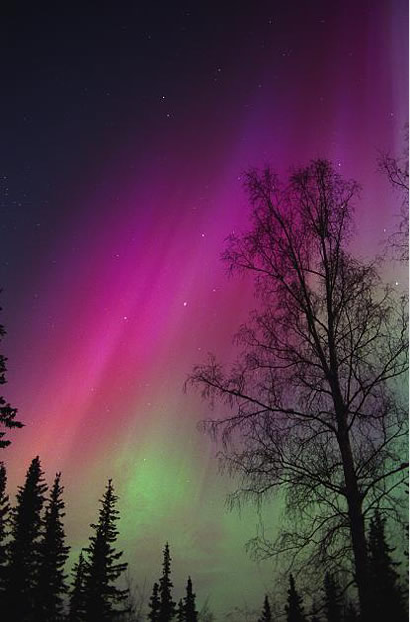Aurora with nitrogen molecular ion emission, Alaska
Aurora with Nitrogen Molecular Ion Emission: A Spectacular Phenomenon in Alaska
Auroras, also known as the Northern and Southern Lights, are one of the most captivating natural light displays on Earth. These mesmerizing celestial events occur in polar regions and are caused by interactions between charged particles from the Sun and the Earth's magnetic field. While auroras are commonly associated with vibrant colors like green and red, there is another fascinating element to these phenomena that occurs in Alaska - nitrogen molecular ion emission.
When we gaze upon the night sky in Alaska during an aurora, we are often treated to a breathtaking sight. The towering rays of light exhibit various types of emissions, each with its own distinct color and origin. At the base, between 90 and 100 kilometers above the Earth's surface, we witness the glow of green atomic oxygen. This emission is caused by collisions between high-energy electrons and oxygen atoms in the upper atmosphere.
As we cast our eyes higher into the sky, we encounter a different shade - red oxygen emissions. These occur at altitudes greater than the green atomic oxygen emissions. The red color results from lower-energy electrons colliding with oxygen atoms, exciting them and causing them to emit light.
However, what truly sets the Alaskan aurora apart is the ethereal display of nitrogen molecular ion emission. Above the red oxygen emissions, we witness radiant hues of purple and pink dancing across the sky. These stunning colors are a result of collisions between electrons and molecular nitrogen ions in the upper atmosphere.
The process begins when high-energy electrons collide with molecular nitrogen (N2), causing it to dissociate into individual nitrogen atoms (N). Subsequently, these nitrogen atoms recombine with other nitrogen molecules, forming nitrogen molecular ions (N2+). When these ions collide with electrons, they release energy in the form of light, creating the beautiful purple and pink hues that grace the Alaskan aurora.
The presence of nitrogen molecular ion emission adds another layer of complexity and beauty to an already awe-inspiring natural phenomenon. It showcases the intricate interplay between charged particles, atmospheric composition, and energy transfer in the upper atmosphere.
To fully appreciate the splendor of an aurora with nitrogen molecular ion emission in Alaska, it is essential to understand the underlying scientific principles at work. Here are some key points to consider:
- Auroras occur when charged particles from the Sun, known as solar wind, interact with the Earth's magnetic field.
- The Earth's magnetic field guides these charged particles towards the polar regions, where they collide with atoms and molecules in the upper atmosphere.
- The collisions excite the atoms and molecules, causing them to emit light of various colors.
- Different colors in an aurora correspond to specific atomic and molecular emissions.
- Green atomic oxygen emissions occur at lower altitudes, while red oxygen emissions occur at higher altitudes.
- Nitrogen molecular ion emissions, characterized by purple and pink hues, take place above the red oxygen emissions.
Witnessing an aurora with nitrogen molecular ion emission in Alaska is a truly magical experience. The vibrant colors and dynamic movements of the celestial light show leave spectators in awe of the wonders of our planet and the universe beyond. It serves as a reminder of the intricate connections between our planet, the Sun, and the cosmos, and invites us to contemplate the beauty and mystery of the natural world. So, if you ever find yourself in Alaska during an aurora, be prepared to be captivated by the extraordinary display of nitrogen molecular ion emission painting the night sky.

Aurora, Alaska
Photographed by Jan Curtis (Aurora site).
The towering rays show several types of emission, green atomic oxygen at the 90-100 km base, red oxygen higher and topped by emissions from nitrogen molecular ions.
Image ©Jan Curtis, shown with permission.
Note: this article has been automatically converted from the old site and may not appear as intended. You can find the original article here.
Reference Atmospheric Optics
If you use any of the definitions, information, or data presented on Atmospheric Optics, please copy the link or reference below to properly credit us as the reference source. Thank you!
-
<a href="https://atoptics.co.uk/blog/aurora-with-nitrogen-molecular-ion-emission-alaska/">Aurora with nitrogen molecular ion emission, Alaska</a>
-
"Aurora with nitrogen molecular ion emission, Alaska". Atmospheric Optics. Accessed on April 18, 2024. https://atoptics.co.uk/blog/aurora-with-nitrogen-molecular-ion-emission-alaska/.
-
"Aurora with nitrogen molecular ion emission, Alaska". Atmospheric Optics, https://atoptics.co.uk/blog/aurora-with-nitrogen-molecular-ion-emission-alaska/. Accessed 18 April, 2024
-
Aurora with nitrogen molecular ion emission, Alaska. Atmospheric Optics. Retrieved from https://atoptics.co.uk/blog/aurora-with-nitrogen-molecular-ion-emission-alaska/.